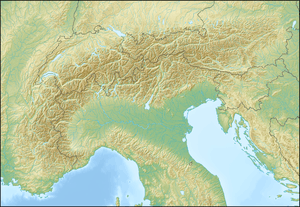Col de Montgenèvre
| Col de Montgenèvre | |
|---|---|
|
The obelisk celebrating Napoleon Bonaparte was erected in September 1804, two months before the First Consul had himself promoted and crowned as emperor. | |
| Elevation | 1,854 m (6,083 ft) |
| Traversed by | Route nationale 94 (France) |
| Location | Hautes-Alpes, France |
| Range | Cottian Alps |
| Coordinates | 44°55′51″N 6°43′24″E / 44.93083°N 6.72333°ECoordinates: 44°55′51″N 6°43′24″E / 44.93083°N 6.72333°E |
 Col de Montgenèvre Location of Col de Montgenèvre | |
The Col de Montgenèvre (Italian: Passo del Monginevro; elevation 1854 m.) is a high mountain pass in the Cottian Alps, in France at two kilometres away from Italy.
Description
The pass takes its name from the village Montgenèvre (Hautes-Alpes), which lies in the vicinity. It links Briançon in the upper Durance valley with the Susa Valley and its communes of Cesana Torinese and Susa in the province of Turin, Piedmont.
The Col de Montgenèvre is an important road connection, and is kept open in winter. Its importance has always lain in the fact that it is the lowest of the principal crossings of the main range of the Alps between France and Italy.
History
It appears to have become first known to the Romans when Pompey used it on his campaign to Spain in 77 BC, claiming to have opened up a route more favorable than hitherto. It was subsequently used by Julius Caesar in travelling to Gaul and became thereafter the main route for travel between Roman Italy and southern Gaul or Spain.
Through this pass Charles VIII of France led his army in September 1494 on his way to capture the Kingdom of Naples, which would spark 65 years of intermittent warfare up and down Italy, later known as the Italian Wars.[1]
Tour de France
The Col de Montgenèvre has appeared on the Tour de France 10 times. The first person over the summit on each occasion was:
- 1949 Tour de France : Gino Bartali Italy
- 1952 Tour de France : Fausto Coppi Italy
- 1956 Tour de France : Valentin Huot France
- 1966 Tour de France : Julio Jiménez Spain
- 1976 Tour de France : Joop Zoetemelk Netherlands
- 1992 Tour de France : Richard Virenque France
- 1996 Tour de France : Bjarne Riis Denmark
- 1997 Tour de France : Richard Virenque France
- 1999 Tour de France : Richard Virenque France
- 2011 Tour de France : Sylvain Chavanel France
See also
References
- ↑ Francesco Guicciardini, Storia d'Italia, Book 1 chapter 9.